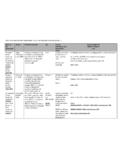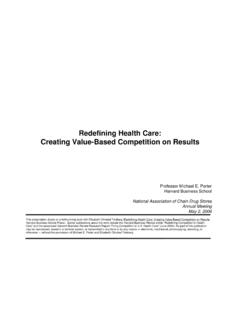Transcription of PROMIS DEPRESSION AND PHQ-9 - PROsetta Stone
1 PROsetta Stone ANALYSIS REPORT. A ROSETTA Stone FOR PATIENT REPORTED OUTCOMES. PROMIS DEPRESSION AND PHQ-9 . SEUNG W. CHOI, TRACY PODRABSKY, NATALIE MCKINNEY, BENJAMIN D. SCHALET, KARON F. COOK. & DAVID CELLA. DEPARTMENT OF medical SOCIAL SCIENCES. FEINBERG SCHOOL OF MEDICINE. NORTHWESTERN UNIVERSITY. This research was supported by an NIH/National Cancer Institute grant PROsetta Stone . (1RC4CA157236-01, PI: David Cella). Authors acknowledge careful reviews, comments, and suggestions from Drs. Robert Brennan, Lawrence Hedges, Won-Chan Lee, and Nan Rothrock. PROsetta Stone PROMIS DEPRESSION AND PHQ-9 . Table of Contents 1. Introduction .. 3. 2. The PRO Rosetta Stone Project .. 3. Patient-Reported Outcomes Measurement Information System ( PROMIS ) .. 4. The NIH Toolbox for Assessment of Neurological and Behavioral Function (Toolbox) .. 4. Quality of Life Outcomes in Neurological Disorders (Neuro-QOL).
2 5. 3. Legacy Instruments .. 5. Patient Health Questionnaire ( PHQ-9 ) .. 5. 4. Linking 6. IRT Linking .. 6. Equipercentile Linking .. 7. Linking Assumptions .. 8. 5. Linking 9. PROMIS DEPRESSION and PHQ-9 (Toolbox Study).. 9. Raw Summed Score Distribution .. 9. Classical Item 10. Confirmatory Factor Analysis (CFA) .. 11. Item Response Theory (IRT) 11. Raw Score to T-Score Conversion using Linked IRT Parameters .. 13. Equipercentile Linking .. 14. Summary and Discussion .. 15. 6. Appendix Table 46: Raw Score to T-Score Conversion Table (IRT Fixed Parameter Calibration Linking) for PHQ-9 to PROMIS DEPRESSION (Toolbox Study). RECOMMENDED .. 17. 7. Appendix Table 47: Direct (Raw to Scale) Equipercentile Crosswalk Table - From PHQ-9 to PROMIS . DEPRESSION (Toolbox Study).. 18. 8. Appendix Table 48: Indirect (Raw to Raw to Scale) Equipercentile Crosswalk Table - From PHQ-9 to PROMIS DEPRESSION (Toolbox Study).
3 19. PROsetta Stone PROMIS DEPRESSION AND PHQ-9 . PRO Rosetta Stone ( PROsetta Stone ) Analysis 1. Introduction A common problem when using a variety of patient-reported outcome measures (PROs) for diverse populations and subgroups is establishing the comparability of scales or units on which the outcomes are reported. The lack of comparability in metrics ( , raw summed scores vs. scaled scores) among different PROs poses practical challenges in measuring and comparing effects across different studies. Linking refers to establishing a relationship between scores on two different measures that are not necessarily designed to have the same content or target population. When tests are built in such a way that they differ in content or difficulty, linking must be conducted in order to establish a relationship between the test scores. One technique, commonly referred to as equating, involves the process of converting the system of units of one measure to that of another.
4 This process of deriving equivalent scores has been used successfully in educational assessment to compare test scores obtained from parallel or alternate forms that measure the same characteristic with equal precision. Extending the technique further, comparable scores are sometimes derived for measures of different but related characteristics. The process of establishing comparable scores generally has little effect on the magnitude of association between the measures. Comparability may not signify interchangeability unless the association between the measures approaches the reliability. Equating, the strongest form of linking, can be established only when two tests 1) measure the same content/construct, 2) target very similar populations, 3) are administered under similar conditions such that the constructs measured are not differentially affected, 4) share common measurement goals and 5) are equally reliable.
5 When test forms are created to be similar in content and difficulty, equating adjusts for differences in difficulty. Test forms are considered to be essentially the same, so scores on the two forms can be used interchangeably after equating has adjusted for differences in difficulty. For tests with lesser degrees of similarity, only weaker forms of linking are meaningful, such as calibration, concordance, projection, or moderation. 2. The PRO Rosetta Stone Project . The primary aim of the PRO Rosetta Stone ( PROsetta Stone ) project (1RC4CA157236-01, PI: David Cella) is to develop and apply methods to link the Patient-Reported Outcomes Measurement Information System ( PROMIS ) measures with other related legacy instruments to expand the range of PRO assessment options within a common, standardized metric. The project identifies and applies appropriate linking methods that allow scores on a range of PRO instruments to be expressed as standardized T-score metrics linked to the PROMIS .
6 This preliminary report encompasses the first wave of 20 linking studies based on available PRO data from PROMIS (aka, PROMIS Wave I), Toolbox, and Neuro-QOL. PROsetta Stone PROMIS DEPRESSION AND PHQ-9 . Patient-Reported Outcomes Measurement Information System ( PROMIS ). In 2004, the NIH initiated the PROMIS1 cooperative group under the NIH Roadmap 2 effort to re-engineer the clinical research enterprise. The aim of PROMIS is to revolutionize and standardize how PRO tools are selected and employed in clinical research. To accomplish this, a publicly-available system was developed to allow clinical researchers access to a common repository of items and state-of-the-science computer-based methods to administer the PROMIS measures. The PROMIS measures include item banks across a wide range of domains that comprise physical, mental, and social health for adults and children, with 12-124 items per bank.
7 Initial concepts measured include emotional distress (anger, anxiety, and DEPRESSION ), physical function, fatigue, pain (quality, behavior, and interference), social function, sleep disturbance, and sleep-related impairment. The banks can be used to administer computerized adaptive tests (CAT) or fixed-length forms in these domains. We have also developed 4 to 20-item short forms for each domain, and a 10-item Global Health Scale that includes global ratings of five broad PROMIS domains and general health perceptions. As described in a full issue of medical Care (Cella et al., 2007), the PROMIS items, banks, and short forms were developed using a standardized, rigorous methodology that began with constructing a consensus-based PROMIS domain framework. All PROMIS banks have been calibrated according to Samejima's (1969) graded response model (based on large data collections including both general and clinical samples) and re-scaled (mean=50 and SD=10) using scale-setting subsamples matching the marginal distributions of gender, age, race, and education in the 2000 US census.
8 The PROMIS Wave I calibration data included a small number of full- bank testing cases (approximately 1,000 per bank) from a general population taking one full bank and a larger number of block-administration cases (n= ~14,000) from both general and clinical populations taking a collection of blocks representing all banks with 7 items each. The full-bank testing samples were randomly assigned to one of 7 different forms. Each form was composed of one or more PROMIS . domains (with an exception of Physical Function where the bank was split over two forms) and one or more legacy measures of the same or related domains. The PROMIS Wave I data collection design included a number of widely accepted legacy measures. The legacy measures used for validation evidence included Buss-Perry Aggression Questionnaire (BPAQ), Center for Epidemiological Studies DEPRESSION Scale (CES-D), Mood and Anxiety Symptom Questionnaire (MASQ), Functional Assessment of Chronic Illness Therapy-Fatigue (FACIT-F), Brief Pain Inventory (BPI), and SF-36.
9 In addition to the pairs for validity ( , PROMIS DEPRESSION and CES-D), the PROMIS Wave I. data allows for the potential for linking over a dozen pairs of measures/subscales. Furthermore, included within each of the PROMIS banks were items from many other existing measures. Depending on the nature and strength of relationship between the measures, various linking procedures can be used to allow for cross-walking of scores. The NIH Toolbox for Assessment of Neurological and Behavioral Function (Toolbox). Developed in 2006 with the NIH Blueprint funding for Neuroscience Research, four domains of assessment central to neurological and behavioral function were created to measure cognition, 1. 2. PROsetta Stone PROMIS DEPRESSION AND PHQ-9 . sensation, motor functioning, and emotional health. The NIH Toolbox for Assessment of Neurological and Behavioral Function 3 provides investigators with a brief, yet comprehensive measurement tool for assessment of cognitive function, emotional health, sensory and motor function.
10 It provides an innovative approach to measurement that is responsive to the needs of researchers in a variety of settings, with a particular emphasis on measuring outcomes in clinical trials and functional status in large cohort studies, epidemiological studies and longitudinal studies. Included as subdomains of emotional health were negative affect, psychological well-being, stress and self-efficacy, and social relationships. Three PROMIS emotional distress item banks (Anger, Anxiety, and DEPRESSION ) were used as measures of negative affect. Additionally, existing legacy measures, , Patient Health Questionnaire ( PHQ-9 ) and Center for Epidemiological Studies DEPRESSION Scale (CES-D), were flagged as potential candidates for the Toolbox battery because of their history, visibility, and research legacy. Among these legacy measures, we focused on those that were available without proprietary restrictions for research applications.






